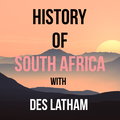
Episode 186 - Cognate Epistemology, TikTok and Nkosi Sandile assaults Alice
Loading player...
Episode 186 it is - we’re taking a closer look at theological suppositions, ecclesiastical superstitions, magic and myth.
Some housekeeping - first thanks to John for taking the time to send a note regarding ecclesiastical and to Mphuthumi for your message about Nkosi Maqoma - I’ll get hold of your book, The Broken River Tent published in 2017.
In this episode we’re going to plunge into a sea of mystery because we’re going to investigate the incredibly diverse history of situations where people believe they can turn bullets into water - or where traditional methods were deployed to deflect incoming projectiles.
These are widely held beliefs which surface in popular ‘millenarian’ movements – usually
uprisings against colonial conditions.
You’ve heard how Mlanjeni’s philosophy had motivated so many to take up arms against the invaders, his message of salvation had spread throughout the Cape. amaXhosa and other people felt it resonated with personally, so they gravitated towards the prophet. amaXhosa chiefs like Maqoma and the paramount Sandile realised that Mlanjeni had the power of persuasion and visited the prophet.
But they weren’t alone because by the mid-nineteenth century, charismatic men and women like Mlanjeni of the amaXhosa had taken to mixing Christianity and animist faiths to create a new way to deal with colonisation. This is a classic process in social structures. The old ways were failing — how could assegai’s beat artillery?
Turn to enchantment, wizadry, spellcraft, mysticism. The missionaries had closely interwoven their Christian message with western civilisation, diametrically opposed to traditionalism. So prophets like Mlanjeni seized part of their narrative, the salvation message, and merged it rather than opposed it using traditional views to distinguish themselves from the missionaries, to coopt the power so to speak.
An ancient philosophy rooted in a world view now threatened by a new industrial powerhouse alter itself, took hold of the strengths of the invader and mixed the message.
Missionaries had preached salvation and many of these millenarian movements used part of the story of the Bible, exodus, the crucifixion, Christ rising from the dead, combined with their own ancient myths and legends, to create a really potent new doctine that made sense.
This is all linked to what anthropoligists and psychologists call Cognate epistemology. It was identified as something that occured between southern African hunters, herders and farmers, San Khoe and bantu speakers. Cross-cultural convictions emerge amongst people who share a common landscape.
Cognate epistemology is the study of knowledge—how we know what we know — exploring questions like "What is knowledge?" and "How do we acquire this knowledge?”
I am by no means denegrating those who believe this. Because another way of thinking about cognate epistemology is how folks like to dive deeply into that pool of disinformation called X and or WhatsApp, sharing social media bilge. The very idea of an influencer itself, correlates almost exactly with those who seek cognate connectivity — advertisers also deploy this concept constantly.
So go tell your favourite influencer on TikTok that they’re indulging in Cognate Epistemology.
When Fort Hare was attacked at 9am on the morning of 21st January 1851, six thousand warriors were yelling Bolowana as they descended on the fortified post. This was going to be the most decisive event of the 8th Frontier War and amaXhosa chief Sandile knew it.
Some housekeeping - first thanks to John for taking the time to send a note regarding ecclesiastical and to Mphuthumi for your message about Nkosi Maqoma - I’ll get hold of your book, The Broken River Tent published in 2017.
In this episode we’re going to plunge into a sea of mystery because we’re going to investigate the incredibly diverse history of situations where people believe they can turn bullets into water - or where traditional methods were deployed to deflect incoming projectiles.
These are widely held beliefs which surface in popular ‘millenarian’ movements – usually
uprisings against colonial conditions.
You’ve heard how Mlanjeni’s philosophy had motivated so many to take up arms against the invaders, his message of salvation had spread throughout the Cape. amaXhosa and other people felt it resonated with personally, so they gravitated towards the prophet. amaXhosa chiefs like Maqoma and the paramount Sandile realised that Mlanjeni had the power of persuasion and visited the prophet.
But they weren’t alone because by the mid-nineteenth century, charismatic men and women like Mlanjeni of the amaXhosa had taken to mixing Christianity and animist faiths to create a new way to deal with colonisation. This is a classic process in social structures. The old ways were failing — how could assegai’s beat artillery?
Turn to enchantment, wizadry, spellcraft, mysticism. The missionaries had closely interwoven their Christian message with western civilisation, diametrically opposed to traditionalism. So prophets like Mlanjeni seized part of their narrative, the salvation message, and merged it rather than opposed it using traditional views to distinguish themselves from the missionaries, to coopt the power so to speak.
An ancient philosophy rooted in a world view now threatened by a new industrial powerhouse alter itself, took hold of the strengths of the invader and mixed the message.
Missionaries had preached salvation and many of these millenarian movements used part of the story of the Bible, exodus, the crucifixion, Christ rising from the dead, combined with their own ancient myths and legends, to create a really potent new doctine that made sense.
This is all linked to what anthropoligists and psychologists call Cognate epistemology. It was identified as something that occured between southern African hunters, herders and farmers, San Khoe and bantu speakers. Cross-cultural convictions emerge amongst people who share a common landscape.
Cognate epistemology is the study of knowledge—how we know what we know — exploring questions like "What is knowledge?" and "How do we acquire this knowledge?”
I am by no means denegrating those who believe this. Because another way of thinking about cognate epistemology is how folks like to dive deeply into that pool of disinformation called X and or WhatsApp, sharing social media bilge. The very idea of an influencer itself, correlates almost exactly with those who seek cognate connectivity — advertisers also deploy this concept constantly.
So go tell your favourite influencer on TikTok that they’re indulging in Cognate Epistemology.
When Fort Hare was attacked at 9am on the morning of 21st January 1851, six thousand warriors were yelling Bolowana as they descended on the fortified post. This was going to be the most decisive event of the 8th Frontier War and amaXhosa chief Sandile knew it.

